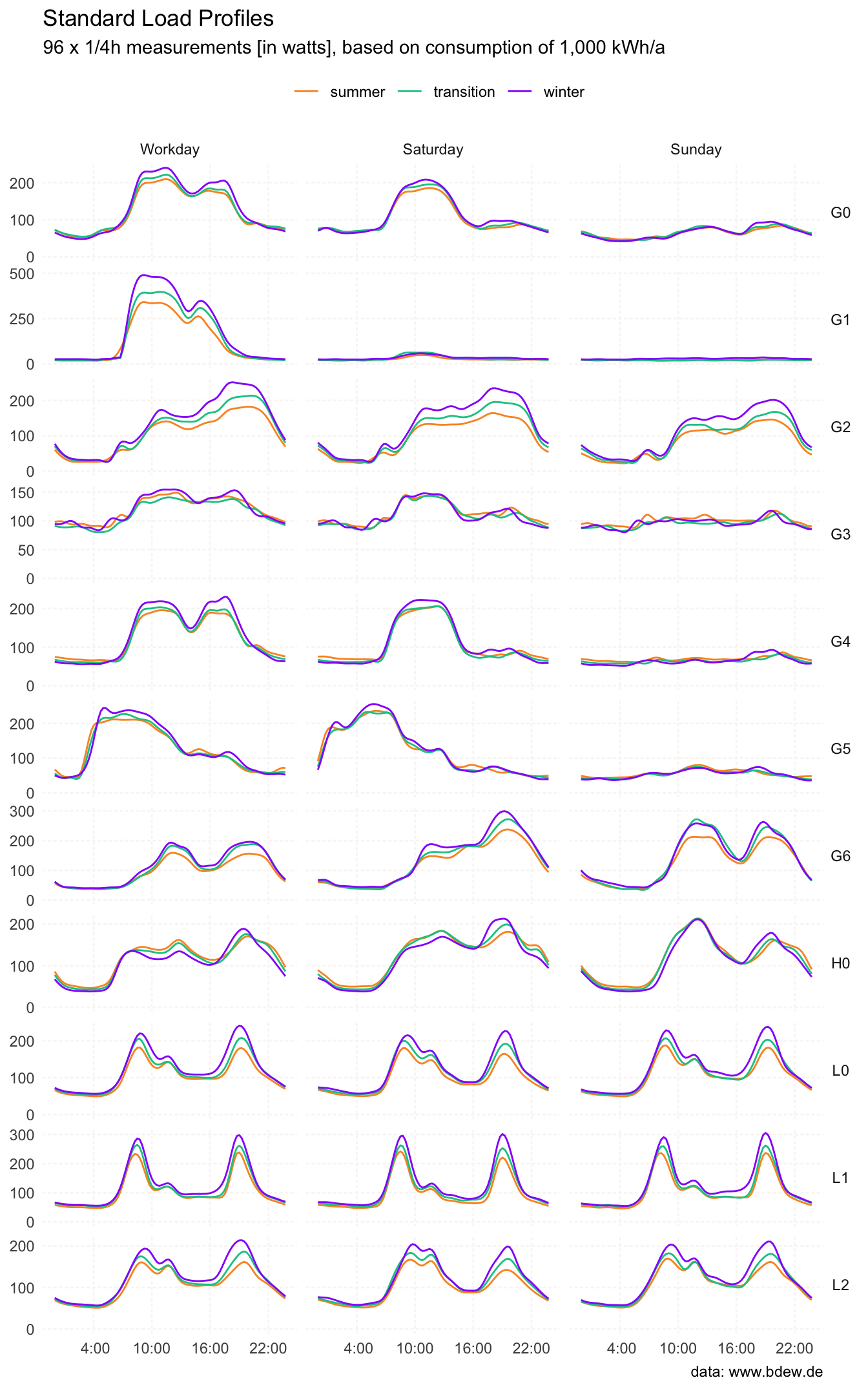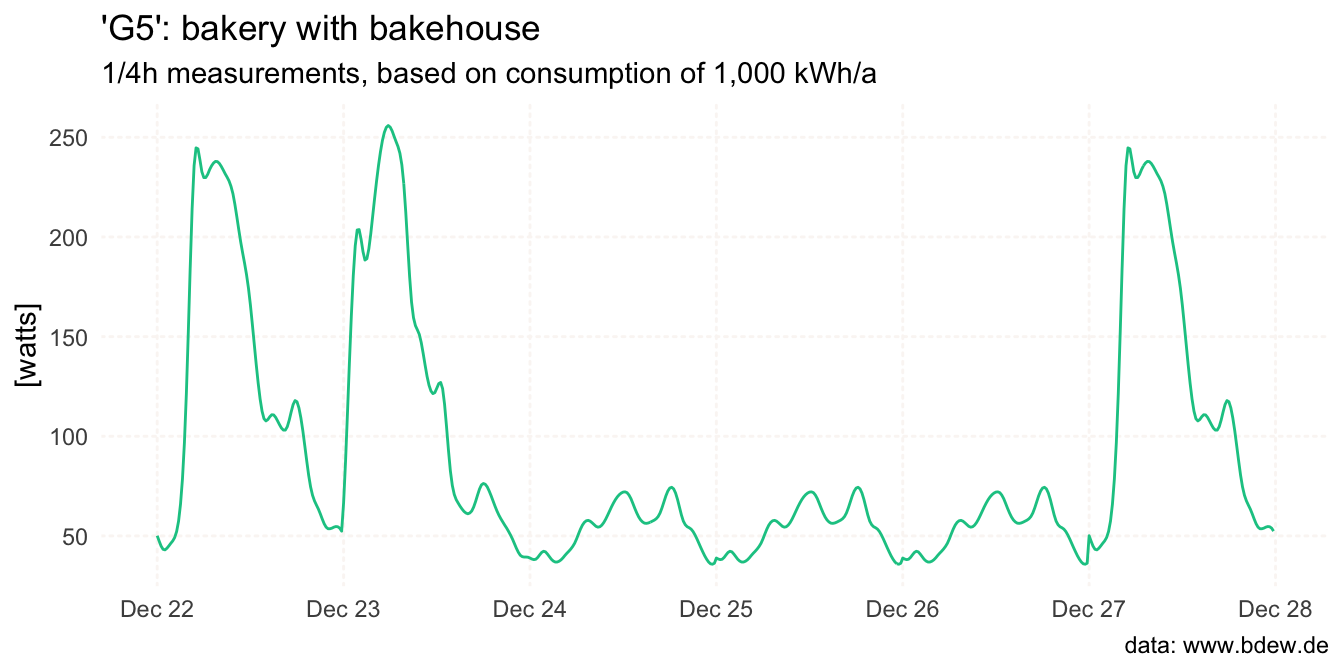This package provides data on representative, standard load profiles for electricity from the German Association of Energy and Water Industries (BDEW Bundesverband der Energie- und Wasserwirtschaft e.V.) in a tidy format.

You can install the development version of standardlastprofile from GitHub, call:
slp – A dataset containing BDEW standard load profiles for electricity.slp_generate() – An interface for generating a standard load profile for a user-defined time period.slp_info() – A function for retrieving details of standard load profiles.The standardlastprofile package encompasses a dataset named slp. This dataset results from an analysis of 1,209 load profiles of low-voltage electricity consumers in Germany, published in 1999.1 It comprises a total of 9,504 observations across 5 variables:
profile_id: identifier of a standard load profileperiod: one of “summer”, “winter”, “transition”day: one of “workday”, “saturday”, “sunday”timestamp: format “%H:%M”watts: electric powerstr(slp)
#> 'data.frame': 9504 obs. of 5 variables:
#> $ profile_id: chr "H0" "H0" "H0" "H0" ...
#> $ period : chr "winter" "winter" "winter" "winter" ...
#> $ day : chr "saturday" "saturday" "saturday" "saturday" ...
#> $ timestamp : chr "00:00" "00:15" "00:30" "00:45" ...
#> $ watts : num 70.8 68.2 65.9 63.3 59.5 55 50.5 46.6 43.9 42.3 ...In the context of the German electricity market, the term ‘Standard Load Profile’ denotes a representative pattern of electricity consumption over a specific period. These profiles portray anticipated electricity consumption for diverse customer groups, like households or businesses. While not an exact match for an individual customer’s consumption profile, they serve as a valid approximation for larger groups of similar customers.
For each unique combination of profile_id, period and day there are 96 x 1/4 hour measurements in watts. If you have no idea what H0 means, you are not alone:
H0: households (German: “Haushalte”)G0 to G6: commerce (“Gewerbe”)L0 to L2: agriculture (“Landwirtschaft”)For more details, call the slp_info() function.
slp_info(profile_id = "H0", language = "DE")
#> $H0
#> $H0$profile
#> [1] "H0"
#>
#> $H0$description
#> [1] "Haushalt"
#>
#> $H0$details
#> [1] "In dieses Profil werden alle Haushalte mit ausschließlichem und überwiegendem Privatverbrauch eingeordnet. Haushalte mit überwiegend privatem elektrischen Verbrauch, d.h. auch mit geringfügigem gewerblichen Bedarf sind z.B. Handelsvertreter, Heimarbeiter u.ä. mit Büro im Haushalt. Das Profil Haushalt ist nicht anwendbar bei Sonderanwendungen wie z.B. elektrischen Speicherheizungen oder Wärmepumpen."To create a standard load profile for a specified time period, call the slp_generate() function:
G5 <- slp_generate(
profile_id = "G5",
start_date = "2023-12-22",
end_date = "2023-12-27"
)
head(G5)
#> profile_id start_time end_time watts
#> 1 G5 2023-12-22 00:00:00 2023-12-22 00:15:00 50.1
#> 2 G5 2023-12-22 00:15:00 2023-12-22 00:30:00 47.4
#> 3 G5 2023-12-22 00:30:00 2023-12-22 00:45:00 44.9
#> 4 G5 2023-12-22 00:45:00 2023-12-22 01:00:00 43.3
#> 5 G5 2023-12-22 01:00:00 2023-12-22 01:15:00 43.0
#> 6 G5 2023-12-22 01:15:00 2023-12-22 01:30:00 43.8
For more information, details about the data, and an explanation of the algorithm, call vignette("algorithm-step-by-step", package = "standardlastprofile").
You can access the studies and data on standard load profiles for electricity by downloading them from the BDEW website: https://www.bdew.de/energie/standardlastprofile-strom/
Please note that this project is released with a Contributor Code of Conduct. By participating in this project you agree to abide by its terms.